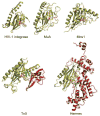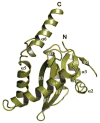Integrating prokaryotes and eukaryotes: DNA transposases in light of structure
- PMID: 20067338
- PMCID: PMC3107681
- DOI: 10.3109/10409230903505596
Integrating prokaryotes and eukaryotes: DNA transposases in light of structure
Abstract
DNA rearrangements are important in genome function and evolution. Genetic material can be rearranged inadvertently during processes such as DNA repair, or can be moved in a controlled manner by enzymes specifically dedicated to the task. DNA transposases comprise one class of such enzymes. These move DNA segments known as transposons to new locations, without the need for sequence homology between transposon and target site. Several biochemically distinct pathways have evolved for DNA transposition, and genetic and biochemical studies have provided valuable insights into many of these. However, structural information on transposases - particularly with DNA substrates - has proven elusive in most cases. On the other hand, large-scale genome sequencing projects have led to an explosion in the number of annotated prokaryotic and eukaryotic mobile elements. Here, we briefly review biochemical and mechanistic aspects of DNA transposition, and propose that integrating sequence information with structural information using bioinformatics tools such as secondary structure prediction and protein threading can lead not only to an additional level of understanding but possibly also to testable hypotheses regarding transposition mechanisms. Detailed understanding of transposition pathways is a prerequisite for the long-term goal of exploiting DNA transposons as genetic tools and as a basis for genetic medical applications.
Conflict of interest statement
The authors report no conflicts of interest. The authors alone are responsible for the content and writing of the paper.
Figures



Similar articles
-
Integrating DNA: transposases and retroviral integrases.Annu Rev Microbiol. 1999;53:245-81. doi: 10.1146/annurev.micro.53.1.245. Annu Rev Microbiol. 1999. PMID: 10547692 Review.
-
Spy: a new group of eukaryotic DNA transposons without target site duplications.Genome Biol Evol. 2014 Jun 24;6(7):1748-57. doi: 10.1093/gbe/evu140. Genome Biol Evol. 2014. PMID: 24966181 Free PMC article.
-
Transposition and site-specific recombination: adapting DNA cut-and-paste mechanisms to a variety of genetic rearrangements.FEMS Microbiol Rev. 1997 Sep;21(2):157-78. doi: 10.1111/j.1574-6976.1997.tb00349.x. FEMS Microbiol Rev. 1997. PMID: 9348666 Review.
-
Transposase subunit architecture and its relationship to genome size and the rate of transposition in prokaryotes and eukaryotes.Nucleic Acids Res. 2018 Oct 12;46(18):9637-9646. doi: 10.1093/nar/gky794. Nucleic Acids Res. 2018. PMID: 30184164 Free PMC article.
-
Mechanisms of DNA Transposition.Microbiol Spectr. 2015 Apr;3(2):MDNA3-0034-2014. doi: 10.1128/microbiolspec.MDNA3-0034-2014. Microbiol Spectr. 2015. PMID: 26104718 Free PMC article. Review.
Cited by
-
Expression of OsHARBI1-1 enhances the tolerance of Arabidopsis thaliana to cadmium.BMC Plant Biol. 2023 Nov 11;23(1):556. doi: 10.1186/s12870-023-04540-0. BMC Plant Biol. 2023. PMID: 37950159 Free PMC article.
-
New insights on the biology of swine respiratory tract mycoplasmas from a comparative genome analysis.BMC Genomics. 2013 Mar 14;14:175. doi: 10.1186/1471-2164-14-175. BMC Genomics. 2013. PMID: 23497205 Free PMC article.
-
Haloquadratum walsbyi: limited diversity in a global pond.PLoS One. 2011;6(6):e20968. doi: 10.1371/journal.pone.0020968. Epub 2011 Jun 20. PLoS One. 2011. PMID: 21701686 Free PMC article.
-
The diversity of prokaryotic DDE transposases of the mutator superfamily, insertion specificity, and association with conjugation machineries.Genome Biol Evol. 2014 Feb;6(2):260-72. doi: 10.1093/gbe/evu010. Genome Biol Evol. 2014. PMID: 24418649 Free PMC article.
-
DNA bending in the synaptic complex in V(D)J recombination: turning an ancestral transpososome upside down.Discoveries (Craiova). 2014 Mar 29;2(1):e13. doi: 10.15190/d.2014.5. Discoveries (Craiova). 2014. PMID: 32309545 Free PMC article. Review.
References
-
- Ariyoshi M, Vassylyev DG, Iwasaki H, Nakamura H, Shinagawa H, Morikawa K. Atomic structure of the RuvC resolvase: A Holliday junction-specific endonuclease from E. coli. Cell. 1994;78:1063–1072. - PubMed
Publication types
MeSH terms
Substances
Grants and funding
LinkOut - more resources
Full Text Sources
Other Literature Sources
